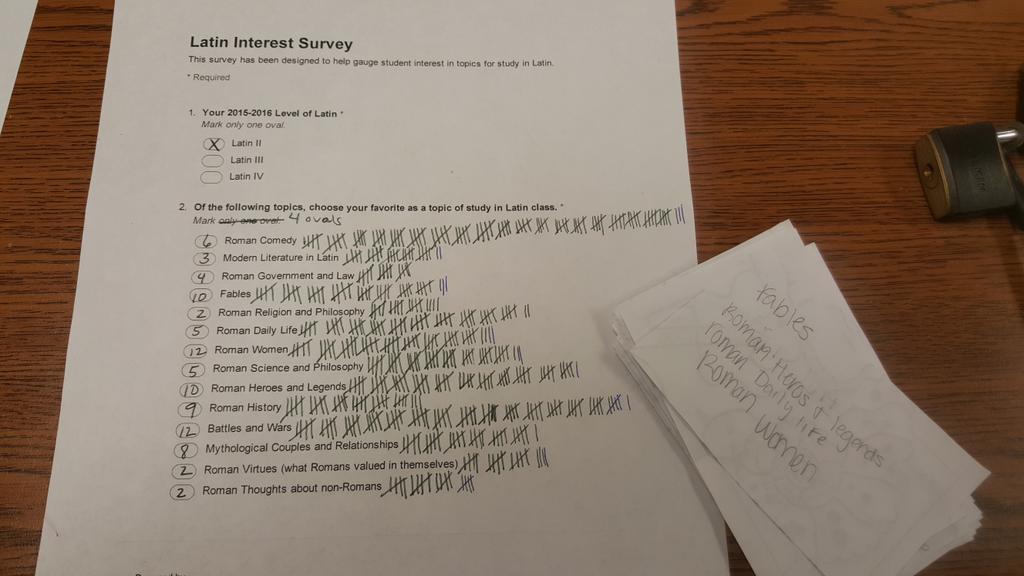The Novella
The big thing I'm working on to get ready for school at this point is writing the novella to review the vocabulary we worked on last year.
I had planned to write my own original novella (which I may still do at some point, just not these last few days of summer), but then something occurred to me that was probably obvious to all of you: it would be more efficient to have students read something based on Roman comedy as our review, since the first unit I'll be teaching that they chose is going to be all about Roman comedy. So instead, I'm adapting Auricula Meretricula to fit their vocabulary and adding in repetitions. My main goal is to keep the sense of humor and reflection of Roman tropes, while culling a great deal of vocabulary.
 |
| My process in picture form. Not pictured: coffee. |
Once I finish adapting the play, I'll compile all the scenes (I'm writing them on separate Google documents right now) and the vocabulary lists (I'm creating separate lists for scenes and one unified vocabulary list all on one Google spreadsheet) into a booklet. Then I'll put our honors society students to use as booklet bundlers, which is totally a thing.
My one concern at the moment regarding the novella is illustration. While I'm not publishing this novella, since the story and situations in it are not my own, I still feel uncomfortable using the illustrations that are original to the book. I am considering making my own, which would be stick figures (I have little motivation to draw anything fancier). I am honestly not sure where I'll end up in terms of illustrating the booklet, but I think images break up longer novels, and just like younger readers, my students are using a lot of their brain power to read a novella in Latin and need the break and comprehension guidance images can provide.
My goal for the novella's length is 2000 or so words, based on Karen Rowan's Las Adventuras de Isabela, which is a charming Spanish novella I borrowed from a neighboring teacher a few years ago. Because of the format of the play, it is difficult to know exactly how many words I'm actually typing (every time I type a character's name to lead into dialogue it counts as a word), but I think I'm on track. Ideally, every word I need reviewed will have no fewer than 15 repetitions; that would mean that when discussing the novel there will be almost endless potential for repeating each word.
Planning
The other thing I'm working on, mostly in the back of my head right now, is planning. This will be the first time I've ever taught a novel in a Latin class; if you teach a modern language you have probably done it before, but access to novels that are accessible and graded and scaffolded is severely limited for Latin teachers. Some of us have started creating these novels, though, so it's an exciting time to be a Latin teacher.
Back to the topic at hand, I am using a planning document that Miriam created that is simple, clear, and helps organization both in planning and prepping for class:
What's brilliant about the document is that it lays out what we're doing and lets me link anything I need for my classes. If we're doing a powerpoint (which is generally a Google slides document for me), I can link it in the plan and then just click it when I need it. Anything I need to project goes there. At the bottom, I can help myself plan by letting myself know whenever I need copies for a class. Ideally I'll do my weekly copies every Friday before I leave; I probably won't every time, but this may help me stay organized enough to do so.
In addition to this microlevel planning (which I have not progressed very far on, as you can see), I am still thinking big picture. I'm thinking the novella will take 2-3 weeks and then I can start introducing new vocabulary and working toward authentic texts. My favorite Roman Comedy stock character is a Parasitus, so I'll be looking for my favorite parasite introduction to use with my students, and aside from that one, the braggart soldier and slave introductions can be interesting. I am also deciding which plays to include scenes from and which not to.
Lastly, in planning the Battles and Wars unit, I have determined that Fridays, after we've read something in Latin that week about a battle or strategy, etc., I'll tell students what has happened in the war against Hannibal so far and let them decide their next moves. I don't know yet if it will take entire class periods or not; this is pure experimentation for me. But I am feeling optimistic.


